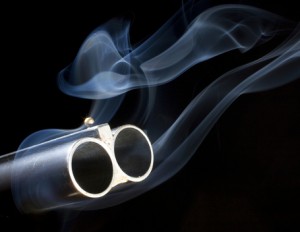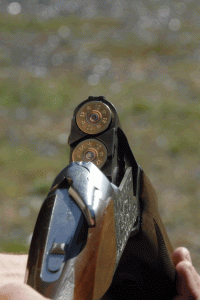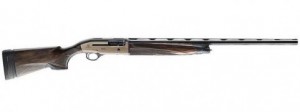Easy Clay Shooting Guide
Basic Shotgun Designs
Semi-Automatic, Over and Under and Side by Side are the 3 main gun designs used by the majority of shooters.
Side by side shotguns are regularly used by traditional game shots. The 2 barrels are next to each other.
Over and unders have barrels on top of each other. Clay shooting favours over and under shotguns.
Semi automatic shotguns are loaded 1 cartridge at once into the breech, as autos only have a single barrel.
The vast majority of adults normally use 12 bore guns as they are the best combination of weight and performance for the vast majority of targets you will see.
20 bore shotgun are smaller and lighter making them ideal for use by ladies, juniors and any shooter wanting less recoil when they shoot.
Required Shooting Equipment
Gun Slip
It is advisable to carry your gun in a quality protective gun slip. It is also good shooting etiquette.
Cartridge Bags & Pouches
There are many different types of cartridge bag on sale, from pouches designed to hold up to 50 cartridges at a time to large holdall type bags which allow you to carry a variety of different cartridges that may be needed for different targets during a competition shoot.
Clay Shooting Eye Protection
Flying bits of broken target can be very sharp and fast moving. Protecting your eyes from debris is common sense and mandatory at shooting venues in the UK.
Ear Protection
Eventually shotguns can harm your ears, so shooting clubs enforce the use of ear defenders while shooting on their premises. These can be disposable ear plugs through to headphones with noise cancelling sensors.
Shotgun Cartridge Information
Cartridges vary from manufacturer to manufacturer. Most shooters find a brand they get on well with with and stick with it.
Shotgun cartridges have 2 main criteria, the load size and the load speed. The bigger the individual lead balls in the shot, the further they will fly, but the the less shot there will be in each shell.
Cartridges with smaller shot have more individual lead balls, but because they are lighter, they don’t travel as far. Many more experienced shooters will use a different shot sized cartridge for specific target types depending on the range.
Different cartridges vary in shot velocity from 1350 – 1650 ft/s. Different velocities favour different shooting styles. For a slower cartridge, you will need to give the target more ‘lead’ so the cartridge pellets have time to reach your target.
Two Disciplines: Skeet and Sporting
Clay Pigeon Skeet Shooting
Skeet shooting is the Olympic discipline and consists of two clay traps referred to as the low and high, at opposite ends of the range facing each other. All over the world, skeet should provide targets that all fly along a very similar flight path, so skeet is almost identical wherever you are.
Skeet has seven shooting stands set out in a half circle between the 2 clay pigeon trap houses, and you shoot a round of twenty five clays as you move around the 7 shooting stands. Good skeet shots will shoot one hundred straight on a regular basis, and it is a discipline based around control and concentration.
Sporting Clay Shooting
Sporting clays imitate different game shooting. You’ll see a range of clays and each stand will offer you a new challenge.
Clay Target Differences
‘Standard’ clays are 110mm dia.
Midi clays are a smaller version of a standard, measuring 90mm across
Mini clays are only 60mm across, but are the same design as standard clays.
Battue – 110mm Diameter – flat, fast and turns and dives when you really wish it wouldn’t.
Rabbit’s are thicker and tougher than standards and mimic a real rabbit, hopping, bouncing and running along the ground.
Principles of Shooting
The skill of shooting is akin to catching a ball. You don’t position your hand to where the ball is, but where the ball’s going to be. In the same way, you shoot to position your lead shot in the path of the flying target.
If you have good coordination and can correctly understand what a target is doing, you will naturally be able to smash it.
Your shot flies in an oval cloud of lead. Your aim is to position that cloud in the path of the clay pigeon.
Understanding what the target object is doing in the air is the skill that will permit your hand/eye coordination to correctly assess the target and break it.
Often, an simple looking target will be misinterpreted by the shooter, making them miss. Clubs like to set optical illusion targets to challenge even the best shooters.
Shooting Techniques
Placing your shot in the right place requires just two things to be right, the speed of your gun movement and the moment in time when you pull the trigger. There are two basic techniques, ‘swing through’ and ‘maintain lead’.
Maintain lead is the easiest shooting technique for people learning to shoot. It involves keeping a set distance in front of the target, tracking its flight through the air. When you are happy that you are the correct distance in front, pull the trigger while still swinging your gun.
Swing through is necessary for some faster and more complex clays and is widely used by advanced shooters. Swing through is a more seat of the pants, gut instinct process.
In the same way that your brain will work out how you can catch a mug you knock off a table, so experienced clay pigeon shooters can break clays without measuring their shot against the target. They just know when to shoot. Shooting is a very satisfying hobby.
Basic Targets
There are 7 different types of clay target used to replicate game in various situations.
Rabbit
Rabbit clays mimic running rabbits. The clays are 110mm in diameter and are stronger than standards as they need to be able to withstand repeatedly hitting the ground.
Simulated Teal
Teal can be difficult to hit. They fly straight upwards very quickly, requiring a seat of the pants, swing through technique that many find difficult. In many instances they can also be hit as they drop as well as rising.
Quartering Clays
By looking at where the target comes from and where it lands you can see how much the target is quartering towards or away from you. Quartering clays need less lead than a crossing target, so knowing its true flight path is important.
Driven Simulated
A clay target that comes straight towards you is called a driven target and simulates driven game. Your barrels will hide the clay just when you want to pull the trigger so you will need to use “the force” to hit them with consistency.
Incomers
Unlike driven birds, which fly over your head, incomers usually drop somewhere in front of you.
Going Away
Clays going away from you get very small very quickly so you need to be on your toes when you call pull.
Loopers
Loopers are moving in several directions at once making them tough little blighters, especially if at range. Quite often they quarter towards or away from you as well, which can deceive your eyesight, as they move through the air.



